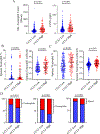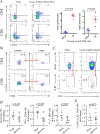CCL5 is a potential bridge between type 1 and type 2 inflammation in asthma
- PMID: 36893862
- PMCID: PMC10330021
- DOI: 10.1016/j.jaci.2023.02.028
CCL5 is a potential bridge between type 1 and type 2 inflammation in asthma
Abstract
Background: Type 1 (T1) inflammation (marked by IFN-γ expression) is now consistently identified in subsets of asthma cohorts, but how it contributes to disease remains unclear.
Objective: We sought to understand the role of CCL5 in asthmatic T1 inflammation and how it interacts with both T1 and type 2 (T2) inflammation.
Methods: CCL5, CXCL9, and CXCL10 messenger RNA expression from sputum bulk RNA sequencing, as well as clinical and inflammatory data were obtained from the Severe Asthma Research Program III (SARP III). CCL5 and IFNG expression from bronchoalveolar lavage cell bulk RNA sequencing was obtained from the Immune Mechanisms in Severe Asthma (IMSA) cohort and expression related to previously identified immune cell profiles. The role of CCL5 in tissue-resident memory T-cell (TRM) reactivation was evaluated in a T1high murine severe asthma model.
Results: Sputum CCL5 expression strongly correlated with T1 chemokines (P < .001 for CXCL9 and CXCL10), consistent with a role in T1 inflammation. CCL5high participants had greater fractional exhaled nitric oxide (P = .009), blood eosinophils (P < .001), and sputum eosinophils (P = .001) in addition to sputum neutrophils (P = .001). Increased CCL5 bronchoalveolar lavage expression was unique to a previously described T1high/T2variable/lymphocytic patient group in the IMSA cohort, with IFNG trending with worsening lung obstruction only in this group (P = .083). In a murine model, high expression of the CCL5 receptor CCR5 was observed in TRMs and was consistent with a T1 signature. A role for CCL5 in TRM activation was supported by the ability of the CCR5 inhibitor maraviroc to blunt reactivation.
Conclusion: CCL5 appears to contribute to TRM-related T1 neutrophilic inflammation in asthma while paradoxically also correlating with T2 inflammation and with sputum eosinophilia.
Keywords: Asthma; CCL5; CCR5; CXCL-10; CXCL9; IFN-γ; maraviroc; tissue-resident memory T cells (TRM).
Copyright © 2023 American Academy of Allergy, Asthma & Immunology. Published by Elsevier Inc. All rights reserved.
Figures





References
-
- Hekking PP, Wener RR, Amelink M, Zwinderman AH, Bouvy ML, Bel EH. The prevalence of severe refractory asthma. J Allergy Clin Immunol 2015; 135:896–902. - PubMed
-
- Wenzel S Severe asthma: from characteristics to phenotypes to endotypes. Clin Exp Allergy 2012; 42:650–8. - PubMed
-
- Brusselle GG, Koppelman GH. Biologic Therapies for Severe Asthma. New England Journal of Medicine 2022; 386:157–71. - PubMed
Publication types
MeSH terms
Substances
Grants and funding
LinkOut - more resources
Full Text Sources
Medical
Research Materials

